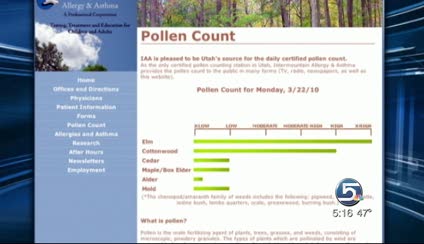Estimated read time: 1-2 minutes
This archived news story is available only for your personal, non-commercial use. Information in the story may be outdated or superseded by additional information. Reading or replaying the story in its archived form does not constitute a republication of the story.
With the arrival of spring, also come the allergies. If your nose or eyes are feeling itchy, it's probably from elm and cottonwood.
One look at the pollen count from Intermountain Allergy and Asthma may make your nose start to itch. Elm is extremely high. Cottonwood is in the high range, and cedar, maple and box elder are close behind.
Dr. Charles Rogers with Allergy Associates of Utah says, "As the season progresses, more trees will reach their levels where pollination is more favorable."

For people whose bodies don't react well to several pollens, Dr. Rogers offers this advice: "It's been found that pollen counts are highest early in the day and in the evening. So if you are somebody who is exclusively sensitive to pollen, you might avoid going out early in the day and towards sunset."
Approximately 20% of Americans suffer from allergies.
According to Dr. Rogers, on warm days with low humidity and high winds, you might want to stay indoors as well.
Allergies account for approximately 10% of all lost workdays in this country.
And when you start to see soft wads of cottonwood blowing in the wind, likely mid-May, don't blame the tree for your allergies.
"In fact, it just so happens that coincides with the grass season," he says. "So they are being fooled. It's not really the cottonwood tree, It's grass pollen."
Grass starts pollinating in the middle of May. Then Rogers says expect a break from allergies starting mid-July to mid August. Then weed season begins.
E-mail: abutterfield@ksl.com









